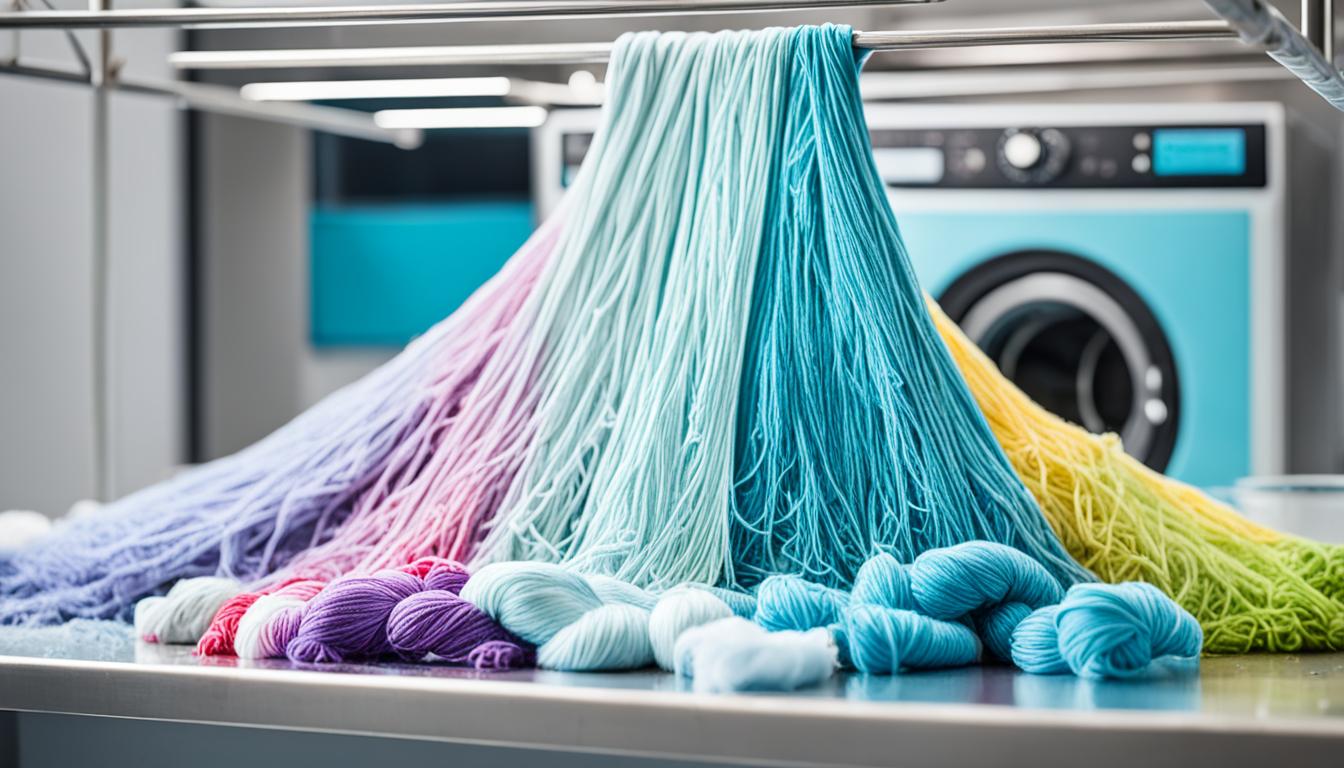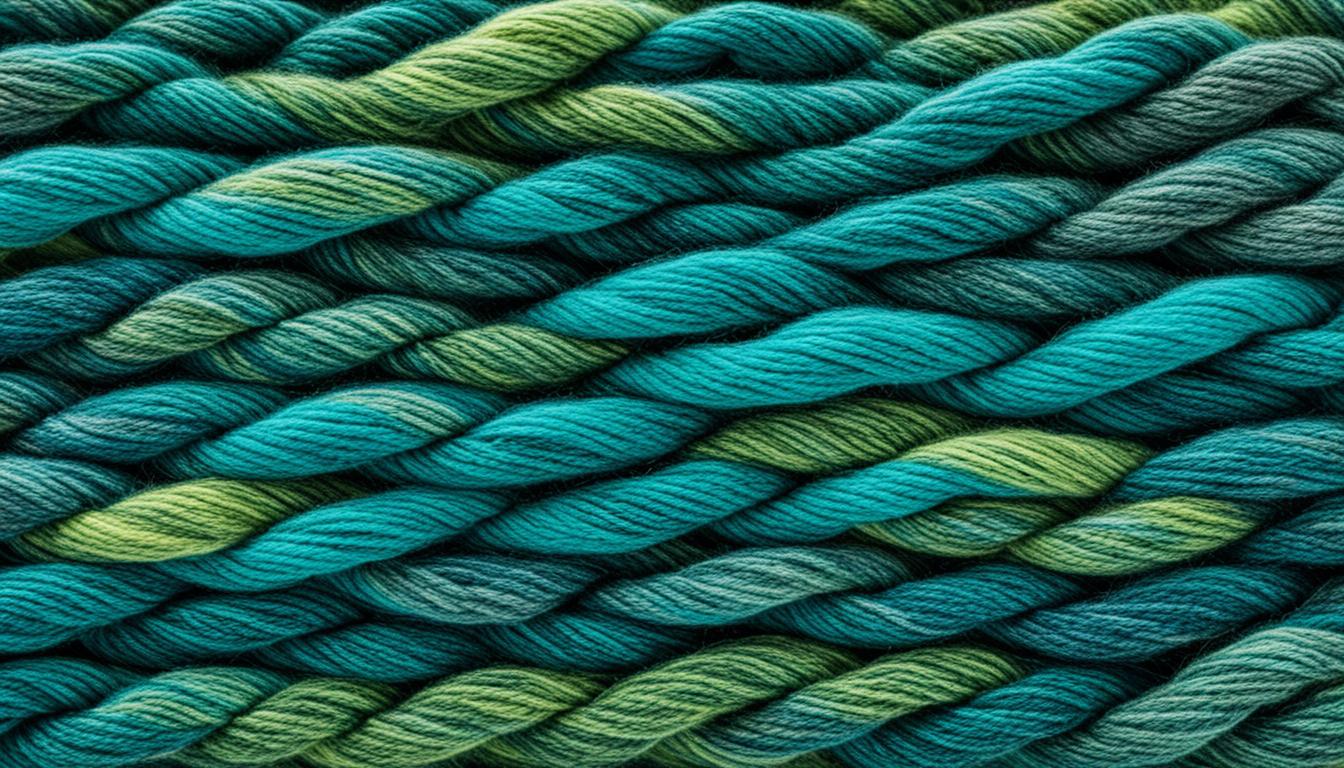Have you ever wondered if it’s safe to get your yarn wet? Maybe you’ve heard conflicting opinions or are worried about potential water damage. Well, we’re here to set the record straight and provide you with the best yarn care instructions to keep your projects looking their best.
When it comes to yarn, proper care is essential to maintain its quality and durability. Whether you’re working with wool, cotton, acrylic, or a blend, knowing how to wash and care for your yarn can make all the difference. So, let’s dive in and learn how to keep your yarn in excellent condition.
Key Takeaways:
- Understanding the washability and quality of your yarn is crucial.
- Each type of yarn requires specific care instructions.
- Wool yarn should be hand-washed to avoid damage.
- Cotton yarn can usually be machine washed on the delicates setting.
- Linen and hemp yarns benefit from rough washing and should be dried flat.
Understanding Yarn Washability and Quality
When it comes to choosing the perfect yarn for your knitting or crochet projects, it’s important to consider both its washability and quality. Understanding how to properly care for your yarn will help ensure that your creations stay beautiful and last for years to come.
When browsing different yarn options, be sure to check the label for specific instructions on how to clean the yarn. Some yarns, such as the Jaeger Extra Fine Merino DK, might recommend dry cleaning or gentle handwashing with soapflakes to maintain their quality. On the other hand, there are yarns that can withstand machine washing, making them more convenient for everyday use.
Our top tip is to always follow the care instructions provided by the manufacturer. These guidelines are designed to help you maintain your yarn’s washability and quality, so it’s important not to overlook them.
Keep in mind that high-quality yarns often require more specific care. These yarns may have unique properties and delicate fibers that need extra attention. By properly caring for high-quality yarns, you can preserve their integrity and ensure they maintain their softness, sheen, and stitch definition.
The combination of washability and quality makes a significant difference in how long your yarn will last and how well it will withstand wear and tear. Investing in higher-quality yarns not only enhances the overall look and feel of your projects but also makes them more durable and resistant to fading or pilling.
By understanding the washability and quality of the yarn you choose, you can make informed decisions that align with your project’s needs and ensure that your hard work pays off. Now, let’s explore some practical tips and techniques for washing specific types of yarn to help you keep your projects looking their best for years to come.
Comparing Yarn Washability and Quality
| Yarn Type | Washability | Quality |
|---|---|---|
| Acrylic | Machine Washable | Durable, Suitable for Everyday Use |
| Wool | Handwash or Dry Clean | Natural, Soft, and Insulating |
| Cotton | Machine Washable | Breathable and Absorbent |
| Linen/Hemp | Handwash or Dry Clean | Sturdy and Cooling |
| Superwash | Machine Washable | Felting-Resistant and Easy to Care for |
Washing Wool Yarn: A Practical Example
When it comes to washing wool yarn, it’s crucial to follow the right care instructions to prevent damage and avoid felting. Wool fibers are delicate, and improper washing techniques can lead to shrinking or weakening of the yarn. To keep your wool yarn in excellent condition, we recommend the following care instructions:
- Handwashing: Start by filling a basin or sink with lukewarm water and add a gentle soapflake specifically designed for wool. Gently agitate the yarn in the soapy water, being careful not to soak it for too long. Excessive soaking can cause the fibers to weaken and lose their shape.
- Cool Rinsing: Rinse the yarn in cool water, ensuring all traces of soap are removed. Avoid using hot water, as it can lead to further felting or shrinking of the yarn.
- Reshaping and Drying: After rinsing, gently squeeze out excess water by pressing the yarn against the edge of the sink or basin. Do not wring the yarn, as this can cause felting. Instead, place it on a clean towel, roll it up, and gently press to remove remaining moisture. Reshape the yarn if necessary and lay it flat on a dry surface away from direct sunlight to dry.
It’s important to note that wool yarn should not be left wet for extended periods, as prolonged exposure to moisture can lead to the breakdown of the fibers. By following these simple washing tips, you can keep your wool yarn looking and feeling its best for all your knitting or crocheting projects.
Benefits of Handwashing Wool Yarn
Handwashing wool yarn has several advantages, including:
- Precise Control: Handwashing allows you to have more control over the cleaning process, ensuring the gentle treatment of delicate wool fibers.
- Preserving Color: Handwashing helps retain the vibrant colors of your wool yarn, preventing any color bleeding or fading.
- Longevity: Proper handwashing techniques can extend the lifespan of your wool yarn, preserving its softness and shape.
“Handwashing wool yarn not only protects its delicate fibers but also gives you peace of mind, knowing that you’re taking the best care of your cherished projects.”
The Importance of Proper Drying
Proper drying plays a crucial role in the care of wool yarn. Avoid hanging wet wool yarn to dry, as the weight of the water can stretch or distort the fibers. Instead, follow these steps:
- Removing Excess Water: After gently squeezing out excess water, you can further remove moisture by using a short spin cycle in the dryer. However, use the lowest heat setting and closely monitor the yarn to prevent over-drying or overheating.
- Laying Flat: To maintain the shape and integrity of your wool yarn, lay it flat on a drying rack or towel away from direct sunlight or heat sources. This ensures even drying without compromising the yarn’s structure.
By following these drying tips, you can avoid unnecessary stretching, shrinking, or damage to your beloved wool yarn.
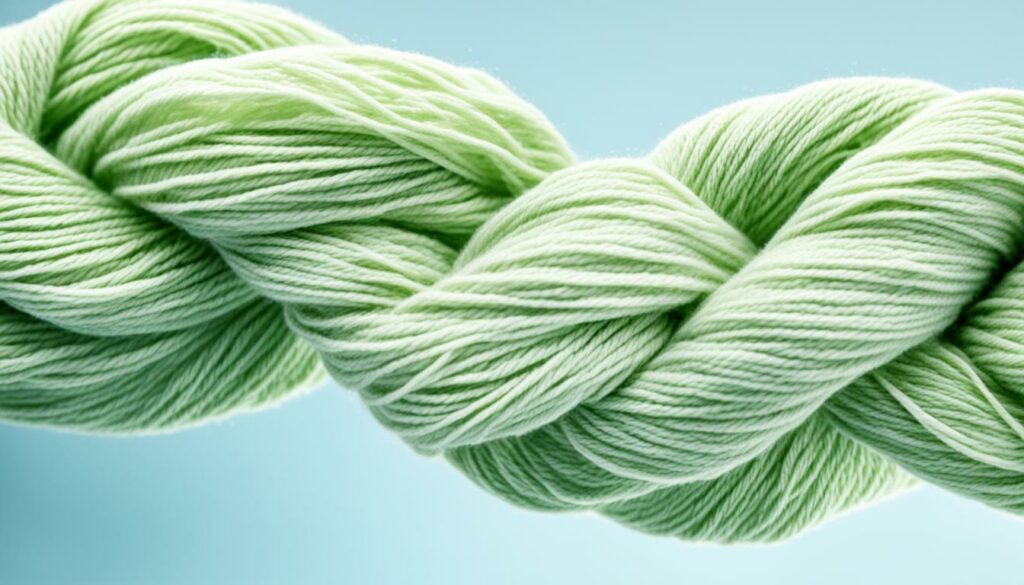
| Wool Yarn Care Instructions | Key Tips |
|---|---|
| Handwashing | Be gentle and avoid excessive soaking or wringing to prevent felting or weakening of the fibers. |
| Cool Rinsing | Rinse wool yarn in cool water to remove soap residues without causing additional felting or shrinking. |
| Reshaping and Drying | After gently removing excess water, reshape the yarn and lay it flat away from direct sunlight to dry properly. |
| No Wringing | Avoid wringing wool yarn as it can lead to felting and damage to the fibers. |
| Proper Drying | Avoid hanging wet wool yarn and opt for gentle spinning or laying flat to maintain its shape and integrity. |
By following these essential wool yarn care instructions and tips, you can ensure that your wool yarn remains in excellent condition, ready for your next knitting or crocheting project.
Care Tips for Cotton Yarn
When it comes to caring for your cotton yarn, you’ll be happy to know that it’s generally easy to maintain. Cotton yarn can usually be safely machine washed, making it a convenient option for many crafters. Here are some care instructions and tips to ensure your cotton yarn stays in great condition.
Washing Cotton Yarn
When washing cotton yarn, it’s best to use the delicates setting on your washer and dryer to minimize shrinkage. This setting helps protect the integrity of the yarn while still effectively cleaning it. However, if your cotton yarn is not mercerized, expect some shrinkage in the wash. To avoid any surprises, we recommend washing a gauge swatch before washing your entire project. This way, you can ensure that the final dimensions will be correct.
Cotton Yarn Care Instructions
Here are some general care instructions to keep in mind when working with cotton yarn:
- Avoid exposing your cotton yarn creations to excessive heat, as this can cause them to shrink or deform.
- If your cotton yarn project requires blocking, consider wet blocking for better results. Wet blocking involves soaking the item in water, gently squeezing out the excess moisture, and shaping it to the desired dimensions. Allow it to dry flat to maintain its shape.
- If your cotton yarn is dyed, be cautious of color bleeding during washing. To prevent color transfer, it’s advisable to wash dyed cotton yarn separately.
- Store your cotton yarn projects in a cool, dry place to prevent any potential mold or mildew issues.
With these care tips in mind, you can confidently create beautiful and long-lasting projects with cotton yarn. Enjoy the softness, versatility, and durability that cotton yarn offers!
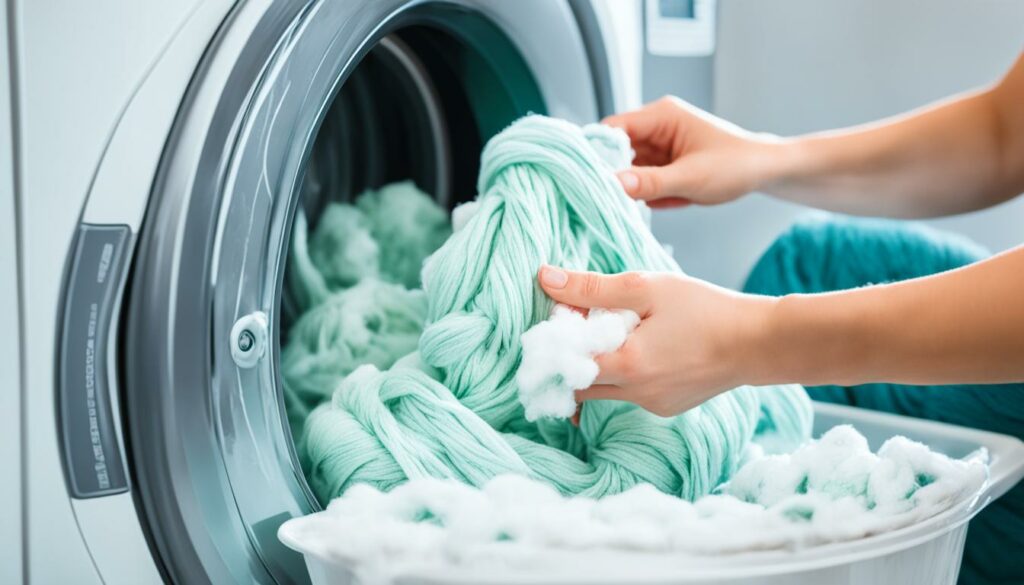
| Washing Method | Pros | Cons |
|---|---|---|
| Machine Wash | – Convenient and time-saving – Suitable for most cotton yarns |
– May cause some shrinkage – Risk of tangling or fraying |
| Hand Wash | – Gentle on delicate cotton yarns – Allows for careful control of water temperature and agitation |
– Time-consuming – Requires more effort – May not remove dirt or stains as effectively as machine washing |
Special Considerations for Linen and Hemp Yarns
When it comes to caring for linen and hemp yarns, there are a few special considerations to keep in mind. These natural fiber yarns require specific washing techniques to enhance their softness while preserving their strength and integrity. Let’s explore some care instructions for linen and hemp yarns.
Washing Techniques for Linen and Hemp Yarns
To achieve optimal softness, linen and hemp yarns benefit from rough washing with greater agitation and pressure. This helps to break down the cellulose fibers, resulting in a softer and more luxurious finished product. When washing linen and hemp yarns, consider the following:
- Washing: Use a gentle detergent and lukewarm water to wash linen and hemp yarns by hand. Avoid using harsh chemicals or bleach as they can weaken the fibers.
- Agitation: Agitate the yarn vigorously by gently scrubbing it with your hands or using a washboard. This increases the contact between the fibers, assisting in softening the yarn.
- Pressure: Apply gentle pressure while washing the yarn. This helps to further break down the cellulose fibers, resulting in a softer texture.
- Rinsing: Rinse the yarn thoroughly with lukewarm water to remove any residual detergent. Ensure that the water runs clear before proceeding to the next step.
After washing, it’s important to lay linen and hemp yarn flat to dry. These fibers have a tendency to wrinkle, so laying them flat helps to preserve their shape and prevents unwanted creasing. Additionally, avoid wringing or twisting the yarn to remove excess water, as this can cause damage. Instead, gently squeeze out the water and then lay the yarn flat on a clean towel or drying rack to air dry.

In summary, washing linen and hemp yarns requires rough washing techniques with greater agitation and pressure. After washing, lay the yarn flat to dry to prevent wrinkling. By following these care instructions, you can enhance the softness of your linen and hemp yarns while maintaining their strength and durability.
| Yarn Care Instructions for Linen and Hemp Yarns | Do’s | Don’ts |
|---|---|---|
| Washing | Use gentle detergent and lukewarm water | Use harsh chemicals or bleach |
| Agitation | Agitate yarn vigorously by hand or with a washboard | Handle yarn too roughly |
| Pressure | Apply gentle pressure while washing | Apply excessive force or pressure |
| Rinsing | Rinse thoroughly with lukewarm water | Leave residual detergent in the yarn |
| Drying | Lay flat to air dry | Wring or twist to remove water |
Caring for Acrylic Yarns
Acrylic yarns are incredibly versatile and easy to care for, making them a popular choice among knitters and crocheters. Whether you’re working on a cozy sweater, a colorful blanket, or a vibrant hat, proper care is essential to keep your acrylic yarn creations looking their best.
One of the great advantages of acrylic yarns is that they can withstand machine washing and drying, making them perfect for everyday use. When washing your acrylic yarn projects, use a gentle cycle and a mild detergent. This will help to preserve the softness and colors of the yarn.
However, it’s important to note that acrylic yarns should not be ironed. The fibers in acrylic yarn can melt under heat, leading to irreversible damage. So, always avoid using an iron on your acrylic projects.
Another common issue with acrylic yarn is friction-induced pilling. Pilling occurs when small balls of fibers form on the surface of the yarn due to friction. If you notice any pilling on your acrylic projects, a fabric shaver can help to remove them gently and restore the yarn’s smooth appearance.
To ensure the longevity of your acrylic yarn projects, it’s crucial to follow the care instructions provided on the yarn label. These instructions may vary depending on the brand and specific type of acrylic yarn.
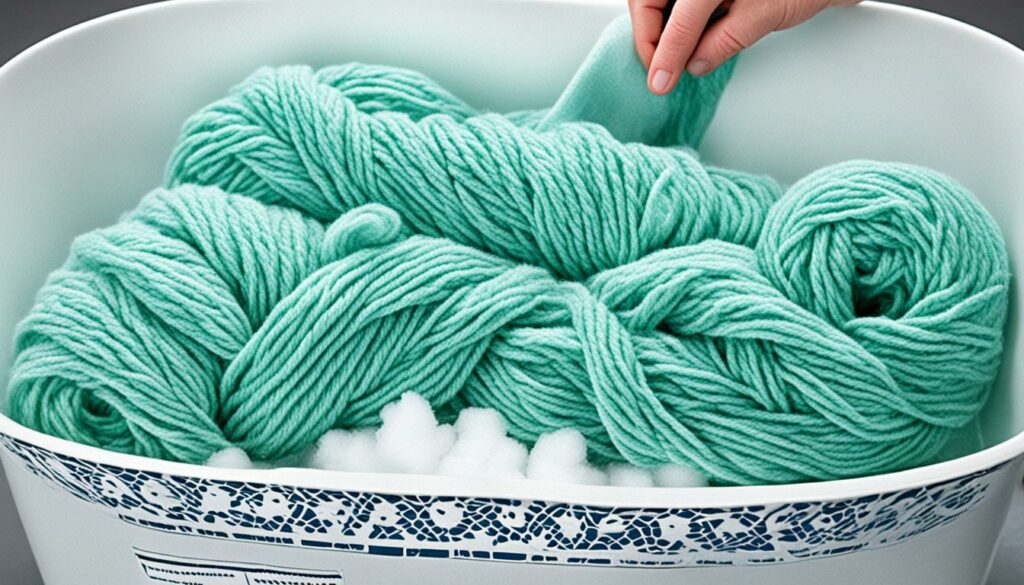
By giving your acrylic yarn the proper care it deserves, you can enjoy your beautiful creations for years to come. The durability and forgiving nature of acrylic yarn make it an excellent choice for projects that require frequent washing, such as blankets and garments.
Remember, always read and follow the care instructions on the yarn label and avoid ironing acrylic yarn. With a little TLC, your acrylic yarn projects will continue to bring warmth and joy!
Exploring Superwash and Yarn Blends
Superwash yarns are a convenient option for knitters who want the benefits of wool without the fear of felting. These yarns have been specially treated to prevent felting, allowing them to be safely machine washed. However, it’s still important to take gentle care of superwash yarns to preserve their quality.
When washing superwash yarns, it’s recommended to use the delicate cycle to minimize any potential damage. Additionally, laying the yarn flat to dry is crucial to prevent stretching or distortion. By following these care instructions, you can ensure that your superwash projects remain in excellent condition for years to come.
On the other hand, yarn blends can offer an exciting combination of different fibers, each contributing its unique characteristics to the yarn. However, because yarn blends can vary in their composition, it’s essential to check the label and follow the care instructions specific to the blend.
Before embarking on a project using a yarn blend, it’s a good idea to knit a test swatch and wash it according to the care instructions. This will help you determine the appropriate washing technique and ensure that your finished project maintains its shape and integrity.
Some yarn blends may have the properties of both fibers, allowing for easy care and machine washing. Others may require a gentler approach, such as handwashing or dry cleaning. By understanding the care requirements of your yarn blend, you can confidently create beautiful projects while preserving the quality of the yarn.
Our Recommended Care Tips for Superwash Yarns:
- Use the delicate cycle when machine washing.
- Lay the yarn flat to dry, avoiding direct sunlight.
- Follow the specific care instructions on the yarn label.
Our Recommended Care Tips for Yarn Blends:
- Check the label for specific care instructions.
- Knit a test swatch and wash it according to the instructions.
- Follow the recommended washing technique for the blend.
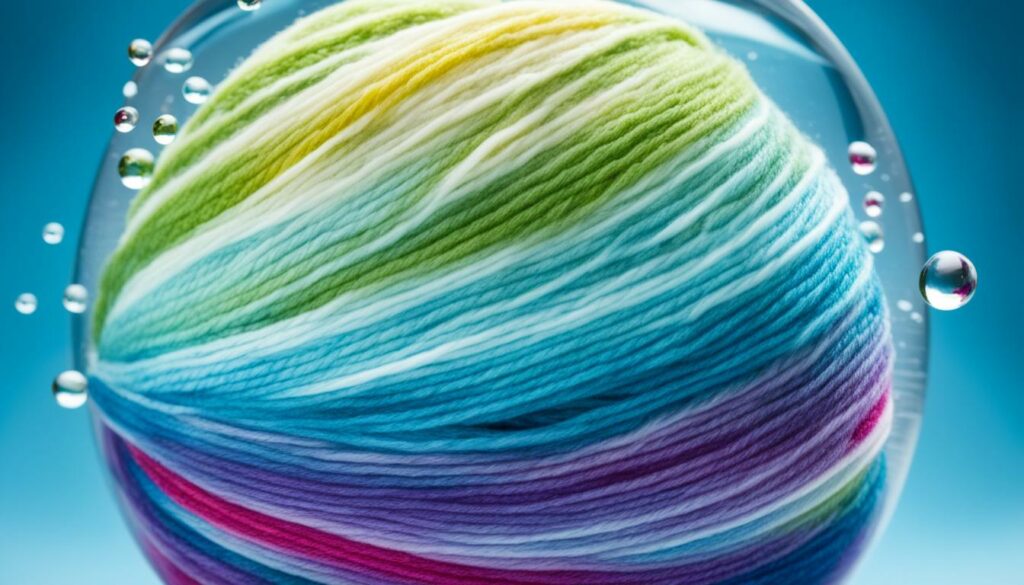
Exploring the world of superwash yarns and blends opens up a world of possibilities for knitters. By understanding the care instructions and taking the necessary steps to preserve the quality of these yarns, you can confidently create stunning projects that stand the test of time.
Can You Machine Wash Superwash Wool?
Superwash wool yarns offer the convenience of easy care, making them a popular choice for many knitters and crocheters. But when it comes to machine washing superwash wool, is it really safe? The answer is yes, but with a few important considerations.
First and foremost, always check the label instructions for your superwash wool yarn. Each yarn may have specific recommendations for machine washing. If the label gives the green light, you can proceed with confidence.
Some knitters may still have reservations about putting their precious superwash wool garments in the washing machine. To address this concern, we recommend conducting your own experiment by comparing hand-washed and machine-washed swatches. This will give you a firsthand understanding of how your specific yarn reacts to different washing methods.
Remember to read the label carefully before attempting machine washing.
Comparing Hand-Washed and Machine-Washed Swatches
By comparing hand-washed and machine-washed swatches, you can evaluate how each method affects the fabric. Follow these steps to conduct your experiment:
- Knit two identical swatches using your superwash wool yarn.
- Hand-wash one swatch according to the yarn label instructions.
- Machine wash the other swatch using the recommended settings on your washer.
- After washing, air dry both swatches.
- Observe and compare the results. Take note of any changes in texture, stitch definition, or overall appearance.
By comparing the hand-washed and machine-washed swatches, you can make an informed decision about the best washing approach for your specific yarn.
Machine Washing Superwash Wool: Tips for Success
When machine washing superwash wool, follow these tips to ensure the best results:
- Use the gentle or delicates cycle on your washing machine.
- Use a mild detergent specially formulated for wool or delicates.
- Place your superwash wool items in a mesh laundry bag to protect them from snagging or tangling.
- Avoid overloading the washing machine to allow enough space for proper agitation.
After the washing cycle is complete, remove your superwash wool items from the machine promptly. Gently reshape and lay them flat to dry, away from direct sunlight or heat sources.
Machine washing superwash wool can be a time-saving and convenient option, but always exercise caution and adhere to the specific instructions for your yarn.

As with any yarn, it’s crucial to treat your superwash wool items with care. Following the recommended washing instructions will help preserve the beauty and longevity of your projects. With proper care, you can enjoy the convenience and durability of superwash wool for years to come.
The Results of Machine Washing Superwash Swatches
In our personal experiment, we tested the effects of machine washing and hand wet-blocking on two types of superwash wool yarn: Ultra Wool DK by Berroco and Rios by Malabrigo. Our goal was to compare the fabric results between the two methods and determine the benefits of machine washing superwash swatches.
After knitting the swatches, we first hand-wet blocked one set according to the yarn label instructions. Then, we machine washed and dried the second set using the delicate cycle on our washer and dryer.
The results were surprising. Both sets of swatches maintained their fabric quality after machine washing, similar to the hand-wet blocked ones. The machine washing process did not compromise the integrity or softness of the superwash wool yarn. This indicates that machine washing superwash swatches can be a convenient and effective alternative to hand wet-blocking.
It’s important to note that every superwash yarn may react differently to machine washing. We recommend conducting your own experiments and testing gauge swatches to determine the best approach for your specific yarn.
Machine washing superwash swatches offers several advantages. Firstly, it helps prevent over-growth of the swatch, ensuring it maintains the desired size. If the swatch has stretched during the knitting process, machine washing can shrink it back to the correct dimensions.

Furthermore, machine washing allows for efficient cleaning of multiple swatches at once, saving time and effort. This is particularly beneficial if you’ve completed a larger project with numerous swatches that require washing.
To summarize, our experiment showed that machine washing superwash swatches can be a viable and effective method. However, it’s essential to read the yarn label instructions and conduct your own tests to ensure the best care for your specific superwash yarn.
| Hand Wet-Blocking | Machine Washing | |
|---|---|---|
| Fabric Quality | Similar to original | Similar to hand-wet blocked |
| Convenience | Time-consuming | Saves time and effort |
| Swatch Size | No control over growth | Prevents over-growth, can shrink back if needed |
Machine Washing Superwash Wool in Comparison to Hand Wet-Blocking
After conducting further experimentation with larger knitted pieces, such as the Low-Key Cowl knit with superwash wool, we have confirmed that machine washing and drying can effectively prevent over-growth of the fabric. This is a valuable alternative to hand wet-blocking, providing convenience and efficiency while maintaining the integrity of your project.
When machine washing superwash wool, it is important to monitor the drying process to prevent excessive wrinkling. To address any potential increase in size, placing the piece in the dryer can help shrink it back to the desired dimensions. However, it is crucial to consult the yarn label and conduct your own experiments to determine how your specific superwash yarn will react to machine washing.
Machine washing versus hand wet-blocking is an ongoing debate among knitters. While hand wet-blocking has traditionally been the preferred method for reshaping and finishing projects, machine washing offers an alternative approach that can save time and effort. By preventing over-growth of the fabric, machine washing can help maintain the intended size of your project without sacrificing quality.
“Machine washing and drying superwash wool can effectively prevent over-growth of the fabric, offering convenience and efficiency while maintaining the integrity of your project.”
It is worth noting that the image below showcases the Low-Key Cowl knit with superwash wool, displaying the outcome of machine washing and drying:
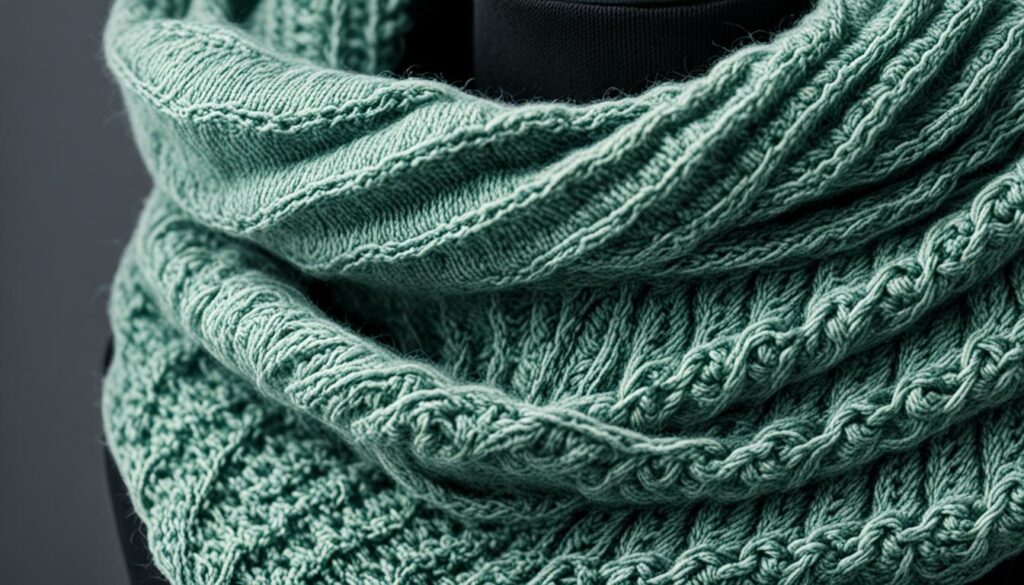
Preventing Shrinkage and Over-Growth
One of the key benefits of machine washing superwash wool is its ability to prevent over-growth. Unlike traditional wool, superwash wool has been specially treated to resist felting and shrinkage. However, it is always important to follow the recommended care instructions on the yarn label to ensure the best results.
Machine washing provides a controlled environment that helps maintain the original size of your project. While hand wet-blocking requires careful shaping and drying, machine washing allows you to avoid the risk of stretching or inadvertently increasing the size of your knitted item.
Conducting Your Own Experiments
Every knitter’s experience with superwash wool may vary, depending on the specific yarn and project. Therefore, we encourage you to experiment with both machine washing and hand wet-blocking to determine which method works best for you.
By knitting swatches and conducting comparative tests, you can gain valuable insights into how your superwash yarn responds to different washing techniques. This firsthand knowledge will empower you to make informed decisions and achieve optimal results with your projects.
To summarize, machine washing superwash wool provides a convenient and efficient alternative to hand wet-blocking. It helps prevent over-growth of the fabric and allows you to maintain the intended size of your project. However, each superwash yarn may react differently, so it is important to read the yarn label and conduct your own experiments to understand how your specific yarn will respond to machine washing.
Conclusion
Properly caring for your yarn is crucial to maintain its quality and longevity. By following the care instructions on the yarn label, you can ensure that your yarn stays in excellent condition for years to come. However, it’s also important to remember that every yarn is unique, and conducting your own experiments can help you determine the best washing techniques for your specific yarn.
Whether you prefer hand-washing or machine-washing your yarn, taking the necessary steps to avoid water damage is essential. Pay attention to the recommended water temperature, use gentle detergents, and avoid wringing or stretching your yarn during the washing process. Remember, even superwash yarns require special care to prevent over-growth or shrinkage.
In conclusion, caring for your yarn is a labor of love. By giving your yarn the attention it deserves, you can prolong its life and enjoy many beautiful projects ahead. So, take the time to read the yarn label, conduct your own experiments, and embrace the joy of washing and caring for your yarn.
